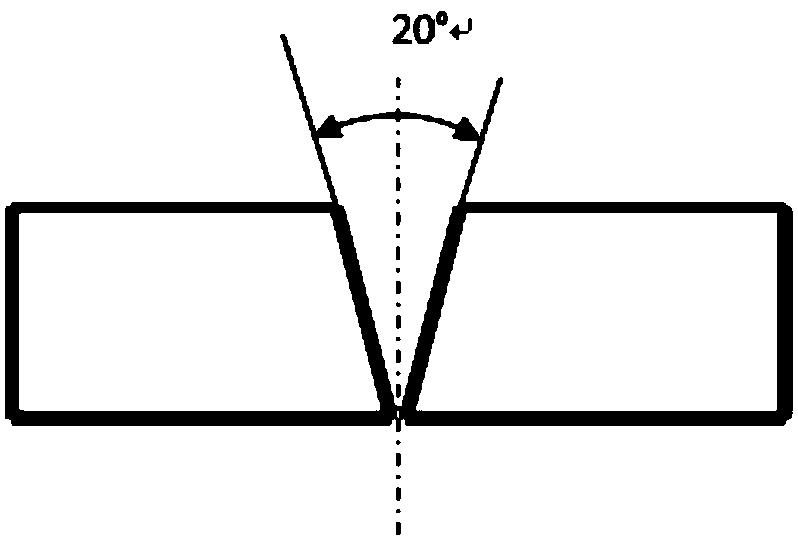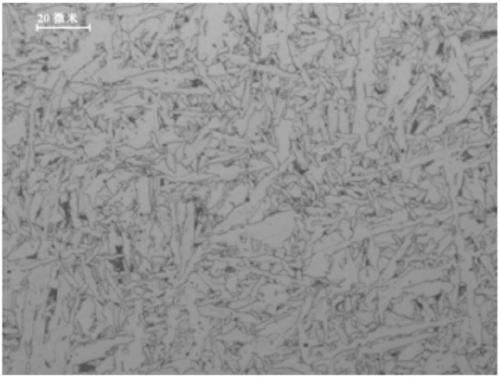Large heat input energy welding high-strength EH36 steel plate and making method thereof
A large input energy welding, EH36 technology, applied in the field of metallurgy, can solve the problems of small resistive input energy, low carbon equivalent, strong toughness, poor operability, etc., and achieve the goal of enhancing market competitiveness, uniform structure of steel plate, and excellent comprehensive performance Effect
- Summary
- Abstract
- Description
- Claims
- Application Information
AI Technical Summary
Problems solved by technology
Method used
Image
Examples
Embodiment 1
[0050] The high-strength ship plate EH36 used for large heat input welding in this embodiment has a thickness of 50mm, and it is smelted from the following components by mass percentage: C: 0.08%, Si: 0.35%, Mn: 1.54%, P: 0.008% , S: 0.003%, Al: 0.005%, Nb: 0.016%, Ni: 0.30%, Ti: 0.015%, Ca: 0.003%, and the balance is Fe and unavoidable impurities.
[0051] The steps of the production method of the high-strength ship plate EH36 for large heat input welding of the present embodiment are as follows:
[0052] (1) Smelting: will contain the following mass percentage components C: 0.08%, Si: 0.35%, Mn: 1.54%, P: 0.008%, S: 0.003%, Al: 0.005%, Nb: 0.016%, Ni: 0.30 %, Ti: 0.015%, Ca: 0.003% molten steel is smelted in an electric furnace first, and sent to an LF refining furnace for refining. When the oxygen content is 15PPM, Ti is used for deoxidation. The temperature is 66.6Pa, and the vacuum holding time is 20 minutes. After the vacuum degassing treatment, add Fe-Ca wire 450m, sof...
Embodiment 2
[0065] The high-strength and high-strength ship plate EH36 used for large heat input welding in this embodiment has a thickness of 70 mm, and is smelted from the following components in mass percentages: C: 0.10%, Si: 0.30%, Mn: 1.55%, P: 0.007%, S: 0.003%, Al: 0.004%, Nb: 0.020%, Ni: 0.28%, Ti: 0.019%, Ca: 0.003%, and the balance is Fe and unavoidable impurities.
[0066] The steps of the production method of the high-strength high-strength ship plate EH36 steel plate for large heat input welding of the present embodiment are as follows:
[0067] (1) Smelting: will contain the following mass percentage components C: 0.10%, Si: 0.30%, Mn: 1.55%, P: 0.007%, S: 0.003%, Al: 0.004%, Nb: 0.020%, Ni: 0.28 %, Ti: 0.019%, Ca: 0.003% molten steel is smelted in an electric furnace first, then sent to an LF refining furnace for refining, when the oxygen content reaches 48PPM, use Ti to deoxidize, and the molten steel temperature reaches 1560°C and transfers to the RH furnace for vacuum d...
Embodiment 3
[0080] The high-strength high-strength ship plate EH36 used for large heat input welding in this embodiment has a thickness of 100 mm, and is smelted from the following components by mass percentage: C: 0.10%, Si: 0.30%, Mn: 1.50%, P: 0.004%, S: 0.003%, Al: 0.004%, Nb: 0.020%, Ni: 0.28%, Ti: 0.019%, Ca: 0.003%, and the balance is Fe and unavoidable impurities.
[0081] The steps of the production method of the high-strength high-strength ship plate EH36 steel plate for large heat input welding of the present embodiment are as follows:
[0082] (1) Smelting: will contain the following mass percentage components C: 0.10%, Si: 0.30%, Mn: 1.50%, P: 0.004%, S: 0.003%, Al: 0.004%, Nb: 0.020%, Ni: 0.28 %, Ti: 0.019%, Ca: 0.003% molten steel is smelted in an electric furnace first, and then sent to an LF refining furnace for refining. When the oxygen content is 95PPM, Ti is used for deoxidation. The temperature is 66.6Pa, and the vacuum holding time is 20 minutes. After vacuum degass...
PUM
| Property | Measurement | Unit |
|---|---|---|
| Yield strength | aaaaa | aaaaa |
| Tensile strength | aaaaa | aaaaa |
| Yield strength | aaaaa | aaaaa |
Abstract
Description
Claims
Application Information
 Login to View More
Login to View More - R&D
- Intellectual Property
- Life Sciences
- Materials
- Tech Scout
- Unparalleled Data Quality
- Higher Quality Content
- 60% Fewer Hallucinations
Browse by: Latest US Patents, China's latest patents, Technical Efficacy Thesaurus, Application Domain, Technology Topic, Popular Technical Reports.
© 2025 PatSnap. All rights reserved.Legal|Privacy policy|Modern Slavery Act Transparency Statement|Sitemap|About US| Contact US: help@patsnap.com



